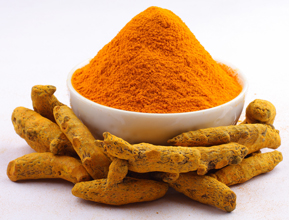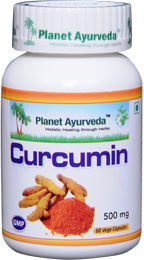Turmeric, Curcumin (Curcuma longa)

Description of plant
Turmeric (Curcuma longa) is perennial herbaceous plant that grows up to 1mt in height. Leaves of this plant are alternate, smooth, green, tapering at both ends and arranged in the pair of two. Leaves are further divided in leaf sheath, leaf blade and petiole. A false stem is arising from the leaf sheath and leaves are about 2 feet in length. This plant produces highly branched, yellow to orange colored, cylindrical and very aromatic rhizomes. Flowering season of the plant is usually month of august and plant produces hermaphrodite flowers. Flowers are dull yellow in color and arranged in the pair of five.
General information
Turmeric is used in Asia from thousand years back. Initially it was used as dye later it became famous for its medicinal uses. In Ayurveda this miraculous herb is known for its medicinal values and used to prepare various medicines. Mostly this herb is used in the form of rhizome powder and pure extract of this herb is used in various ayurvedic preprations. In Ayurveda used this wonderful herb to cure internal disorders such as indigestion, common cold and various liver associated disorders. Externally it is used in wound healing and various skin related disorders.
This herb is very popular in Indian wedding ceremonies and religious ceremonies. Haldi ceremony is very important part of weddings in Hindu tradition. In this tradition turmeric paste is applied on bodies of couples and its benefit is to soften the skin and to protect booth bride and groom from bad evils. In Tamil Nadu during the festival of pongal these rhizomes are used in the worship of sun god i.e. God Surya. It is a poor fabric dye and used to dye the clothes. It is also used in Indian cuisines, pickles, curries, salads and also used to preserve canned food.
Major chemical compounds available in this herb are curcumene, curone, curidone, curcumenone, curzerenone, cineole, eugenol, epiprocurcumenol, camphene, camphor, bornel, curcumins, beta-sitosetrol, procurcumadiol and procurcumenol.
Special note about Curcuma longa
हरिद्रा प्रमेहहराणाम्।
There are numerous herbs that are used in the treatment of diabetes but no herb is used in the comparison of turmeric. This herb is best used in the treatment of diabetes. It is used as both curative and preventive agent.
Habitat
Turmeric is mainly native to India. It is also found in tropical regions of Africa and also cultivated in China, Indonesia, Thailand, and Cambodia, Philippines, Malaysia, Madagascar and Vietnam.
Classification
- Kingdom – Plantae
- Order – Zingibrales
- Family – Zingibraceae
Names
- Hindi name – Haldi, Haridra
- English name – Turmeric
- Telugu name – Pasupu, Pasupu kommulu
- Tamil name – Manjal
- Kannada name – Arishina
- Gujarati name – Haladar
- Punjabi name – Haldi, Halaj, Haldar
- Marathi name – Halad
- Arabian name – Kumkum
- Malayalam name – Manjal
- Farsi name – Zardchob
Watch Video on Turmeric Herb by Dr. Vikram Chauhan (MD Ayurveda)
Ayurvedic Properties
| Hindi / Sanskrit | English | ||
| Rasa | Tikta, Katu | Taste | Bitter, Pungent |
| Guna | Laghu, Ruksha | Physical Property | Light, Dry |
| Virya | Ushna | Potency | Hot |
| Vipaka | Katu | Metabolic Property (After Digestion) | Pungent |
Effects on Doshas
It balances all three doshas in body i.e. vata, pitta and kapha.
| Charak Samhita | Sushrut Samhita | Vagbhata | Bhavprakash |
|
|
|
|
Ancient verse about Curcuma longa

The Bhavprakash nighantu edition of 2010: verse 196-197, page no-111.
It states that haridra, kanchani, peeta, nishakhya, varvarini, krimghni, haldi, yoshitripya and hatvilasini all are synonyms of curcuma. This herb is pungent and bitter in taste, rough, hot in potency and used to pacify kapha and pitta dosha. It is used to improve skin tone and used in skin disorders, diabetes, bleeding disorders, inflammation, and anemia and used in wound healing.
Reference:
The Bhavprakash nighantu with elaborated Hindi commentary by Padmashri prof. K.C. Chunekar, edited by Late Dr. G.S. Pandey: edition of 2010: haritkayadi varga; verse 196-197, page no-111.
Other types that are similar to Haridra (Herbs A-Z)
- Kapoora Haldi/ Aamahaldi (Curcuma amada)
- Van Haldi (Curcuma aromatica)
- Kali Haldi (Curcuma caesia)
1. Kapoora Haldi/ Aama haldi (Curcuma amada)
Kapoora Haldi or Aama Haldi (Curcuma amada), commonly known as mango ginger, belongs to the Zingiberaceae family. It resembles ginger in appearance but has a distinct raw mango aroma. Traditionally, it is used for its anti-inflammatory, antibacterial, and digestive properties. It helps treat skin allergies, itching, indigestion, respiratory issues and joint pain. The rhizome can be used fresh or dried in the form of paste, powder, or decoction. Its mild, soothing nature makes it useful in various home remedies, especially for skin and stomach-related ailments. Its other properties are similar to Adrak/Ginger except potency, which is cold (Ginger has hot potency).
2. Van Haldi (Curcuma aromatica)
Curcuma aromatica, commonly known as Wild Turmeric or Van Haldi, is a medicinal plant belonging to the Zingiberaceae family. It is well-known for its fragrant rhizome and is traditionally used in skincare for its antiseptic, anti-inflammatory and antioxidant properties. This turmeric variety is often used in face packs, especially for improving complexion and treating acne, blemishes and skin infections. It is also applied to wounds to promote healing. Unlike common turmeric (Curcuma longa), it is less pungent and more aromatic, making it suitable for external use and cosmetic formulations.
3. Kali Haldi (Curcuma caesia)
Kali Haldi (Curcuma caesia Roxb.), commonly known as Black Turmeric, is a rare medicinal plant belonging to the Zingiberaceae family. It has dark, bluish-black rhizomes with a distinct camphor-like aroma. Traditionally used in Ayurvedic and folk medicine, it is valued for its anti-inflammatory, analgesic, antioxidant and antimicrobial properties. It is used in the treatment of pain, wounds, skin diseases, respiratory issues and even spiritual or ritualistic purposes in some cultures. The rhizome is often used in paste or powder form for external application.
Practical uses from Curcuma longa
- Curcuma is used as blood purifier and it is used in the treatment of atherosclerosis, it is used to remove accumulation in the blood vessels and used to remove toxins from the body. It is used to expel out extra kapha and meda dosha from body.
- It is used in the treatment of diabetes. Turmeric herb is very effective herb that is used in the treatment of diabetes.
- Being anti-inflammatory this herb is used to reduce inflammation and used in the treatment of bone related disorders,
- Being a stimulant it is used to stimulate digestive fire and it is used as stomach tonic and used in various ailments associated with digestive system.
- Externally its paste is used for wound healing and it is also helpful to rejuvenate skin tone. It is used to heal sores and also used in various cosmetics.
- Externally it is used in the treatment of insect bites, wound healing. It is also used in the treatment of ring worms and also used to relieve inflammation and bleeding of gums.
- It is anti-bacterial and anti-oxidant in nature and used in the different body disorders.
- Externally its paste is used in the treatment of acne and pimples. It is also beneficial to treat anemia.
- It is main home remedy to cure common cold and cough.
- It is used to reduce symptoms of skin cancers and it is also very effectively used in the treatment of breast cancer.
- Due to its hot potency it is used to pacify kapha and vata dosha and due to its dry properties, bitter and pungent taste this herb is used in the pacification of kapha dosha.
Ayurvedic product from Curcuma longa
Curcumin Capsules
Curcumin Capsules are natural herbal supplement available at house of planet Ayurveda in which pure curcumin is used. Curcumin is active biological compound of turmeric. It is very effective herb for curing digestive disorders and skin aliments. This formulation is also used in the treatment of cancer. Its regular intake is used to reduce extra toxins and used to protect free radicals from body. It is anti-inflammatory and anti-septic in nature.
Part used
Rhizome
Dosage
- Fresh juice: 10-20ml
- Powder: 1-3gm





1 thought on “Turmeric / Curcumin / Curcuma longa”